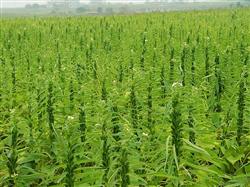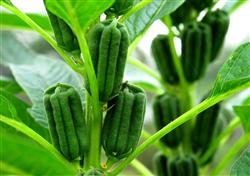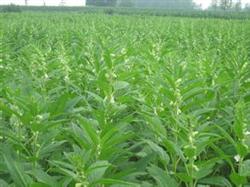There are keys to fertilization for high yield of sesame.

In order to obtain high quality and high yield of sesame, scientific and rational fertilization is the key. Production practice has proved that the key point of fertilizing sesame lies in the grasp of timing and methods, and requires that seedling fertilizer should be "early", bud fertilizer should be "skillful" and flower fertilizer should be "heavy". Let's talk about specific methods for reference. Early application of seedling fertilizer sesame because the seeds are small, coupled with often too much nitrogen fertilizer, it is easy to make the seedlings grow and form tall seedlings. Therefore, sesame should be combined with early seedling, early seedling, early application of quick-acting fertilizer is an important measure for early development and growth of sesame. In seedling stage, it is better to dilute mature human feces and urine or urea. Generally, 2kg of urea is applied per mu after seedling setting. When drought is serious, drought resistance should be followed by topdressing or diluted with thin human feces and urine and then irrigated. For those with poor seedling situation, we should also adopt the method of "opening special meals" and apply fertilizer for seedlings. In order to apply seedling fertilizer to sesame, it should be applied shallowly or mainly to the root according to the characteristics of shallow root system of sesame. The budding stage of sesame with skillful application of bud fertilizer is entering the period of flower bud differentiation, when the plant vegetative growth and reproductive growth flourish at the same time. Therefore, the application of bud fertilizer is very important for the high yield of sesame. In general, bud fertilizer is mainly nitrogen fertilizer, supplemented by phosphorus and potassium fertilizer. When fertilizing, the strip sowing can be ditched or applied at a depth of 10 cm from the sesame plant, in order to absorb the root and cover the soil; for the sowing, the rotten cake fertilizer or granular urea can be fully mixed into the fine broken soil, and then ploughed and loosened to cover the soil immediately after fertilization. When the weather is dry, water should be sprayed after application to give full play to the fertilizer effect. The watering method can also be used, that is, each mu is sprinkled with urea 4kg / mu and 200kg / mu with water. In addition, boron fertilizer should be applied to boron-deficient areas and boron-deficient soils as appropriate. With the re-application of floral fertilizer, sesame grows most rapidly in the flowering stage, which accounts for 70% and 80% of the nutrients absorbed during the whole growth period. In order to meet the needs of plant growth and development, make sesame grow vigorously, accumulate more photosynthates, increase the number of flower capsules, stabilize growth in the later stage without early senescence, and make grains full, flower fertilizer must be re-applied. At the same time, a large number of lateral roots began to form at flowering and pod stage, the absorptive capacity of roots was enhanced, the growth rate of plants was accelerated, and the demand for nutrients also increased significantly. Therefore, it is necessary to re-apply flower and pod fertilizer, generally using urea 5kg / mu and water 200kg / mu to pour on the sesame grass, and can also apply retting cake fertilizer, human manure and so on. In addition, extra-root topdressing can be carried out from the beginning of flowering to full flowering, by spraying 0.3% potassium dihydrogen phosphate solution on both sides of the leaves on a sunny afternoon, with an interval of 5-6 days each time.
- Prev

Chasing "three fertilizers" for high yield of sesame
Double-stem cultivation is that the tip of the main stem is removed at the seedling stage of sesame, and the axillary buds at the base of the stem are used to promote the growth of two stalks similar to the original main stem, which can greatly increase the number of pods and increase the yield. Generally increase the income of sesame seeds by about 10 kilograms per mu. Therefore, double-stem cultivation is a new method for high yield of sesame.
- Next

High yield fertilizer application of sesame
⑴ sesame seed preparation has small seeds, weak root system and slow seedling growth. Fine soil preparation is one of the important measures to sow whole and strong seedlings. Sesame is afraid of waterlogging, so in low-lying and rainy areas, on the basis of ploughing and land preparation, ditches should be made to do a good job of drainage and waterlogging prevention. Tianjin urban area has less rain and snow in spring, sowing sesame seeds in spring, raking and raking in winter.
Related
- The first cup of black tea in spring, the flavor and history of tea gardens in Kenya, Africa
- The computer can not only choose potatoes, but also grow tea rice. AI will grow winter oolong tea champion.
- It is not only the inflated tea bitten by insects, but also engraved with the four seasons tea in Beipu.
- The Oriental Beauty Tea Festival in Zhuxian County takes the stage at the weekend to experience the plus-size feast of oil tea.
- & quot; Oriental Beauty Tea & Exploration of Emei in Hsinchu, the hometown of quot;
- The new variety of strawberry "Tainong 1" dessert is the first choice with mellow aroma. Crimson gorgeous
- History of Tea in Taiwan: from Wild Inner Mountain to Export Tea Garden
- Two types of Taiwan Oriental Beauty Black Tea won the British three-Star Award for Childhood Tea Xiang Zhang Jiaqi changed from pilot to champion tea maker.
- Banana species and varieties: the planting history of Taiwan Xianren banana and dwarf banana is long, is banana disease resistant?
- Coffee planting Technology: Qianjie Coffee from Seedling to harvesting

